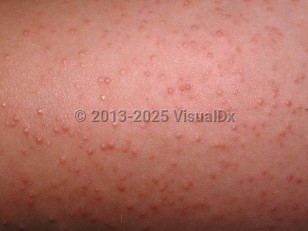Keratosis pilaris is an exceedingly common, benign skin disorder of the follicular orifice, commonly referred to as "gooseflesh" or "chicken skin." It is characterized by small follicular papules on the posterior upper arms and thighs due to the retention of keratin at the follicular opening. It is seen most frequently in children, adolescents, and young adults, and is particularly common in individuals with
xerosis or underlying
eczema. Dry weather may make these skin changes more pronounced. Frequently, there is a family history of the condition. Autosomal dominant inheritance with variable penetrance has been described.
Keratosis pilaris rubra is a nonatrophic variant associated with background erythema and often has facial involvement.
Three rarer atrophic clinical variants that have hyperkeratotic follicular papules with varying degrees of atrophy also exist:
- Keratosis pilaris atrophicans faciei is characterized by erythematous, hyperkeratotic papules distributed on the lateral third of the eyebrows in young children with associated atrophy and hair loss in the affected areas.
- Atrophoderma vermiculatum (also termed honeycomb atrophy) is characterized by atrophic pits in a reticulate or worm-eaten array localized to the face of older children.
- Keratosis follicularis spinulosa decalvans is a disorder characterized by widespread keratosis pilaris, scarring alopecia, and eye abnormalities.
Keratosis pilaris is seen with increased incidence in several syndromes and disease states. In addition to
atopic dermatitis, these include
ichthyosis vulgaris, diabetes (
type1,
type 2),
obesity,
erythromelanosis follicularis faciei et colli (erythema, brown pigmentation, and keratosis pilaris),
Down syndrome,
Ehlers-Danlos syndrome,
Graham-Little-Piccardi-Lassueur syndrome (cicatricial alopecia of the scalp, loss of pubic and axillary hairs, and keratosis pilaris),
cardiofaciocutaneous syndrome,
Noonan syndrome, and
woolly hair syndrome.
In addition, keratosis pilaris-like drug eruptions have been described in association with
BRAF or
MEK inhibitor therapy.



 Patient Information for
Patient Information for 
